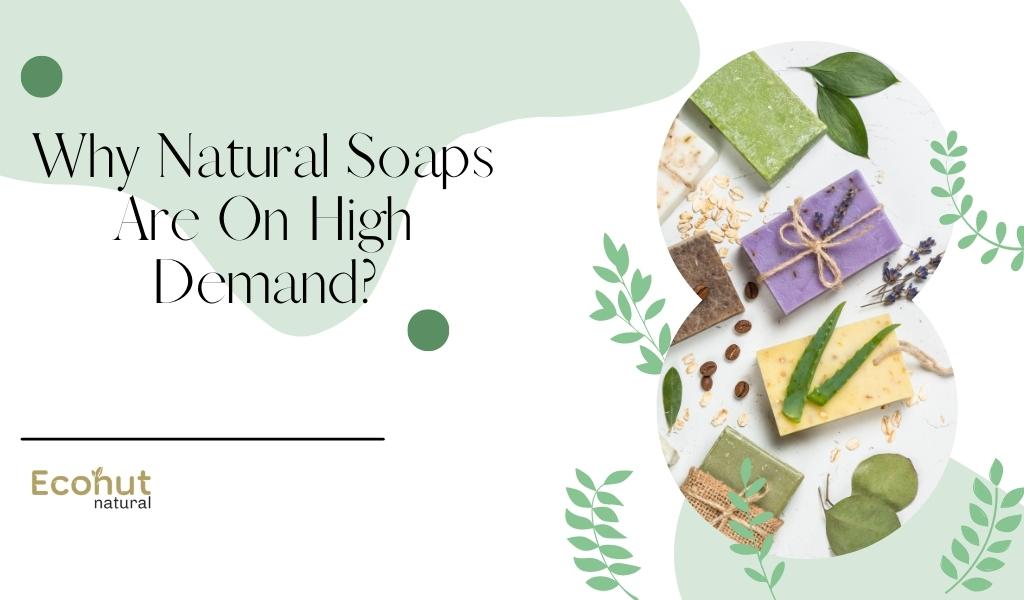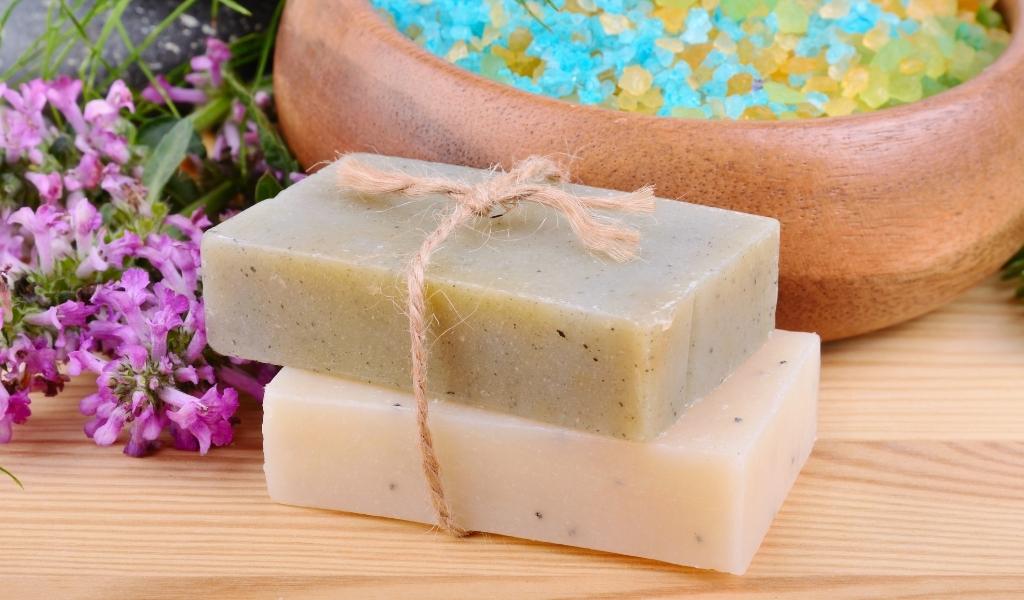Despite steady and high consumer demand for the Beauty and Personal Care goods, or BPC, businesses are experiencing expansion at a quick rate. While witnessing transformations such as consumer movement from synthetic products to organic ones. Furthermore, Natural Bathing Soaps contain Herbal and organic components. Organic ingredients have few or no known negative effects because they lack additives and preservatives. As a result, rivals are progressively developing organic soaps in order to acquire market share. Furthermore, customers are increasingly more concerned about skin health and environmental well-being. Thus, one of the primary market drivers for organic soap is the shift in customer preference for natural soap over traditional and synthetic soaps.
Why Using Natural Bathing Soap Is Better for Your Skin?
The most popular type of soap is bar soap, which comes in the shape of solid cakes. These soaps aid in body cleaning and are simple to use and store. Because of their numerous advantages, bar soaps have the biggest market share in the soap sector. These soaps are preferred over liquid soaps due to their economic value, ability to deodorize, environmental friendliness due to the lack of plastic bottles, stronger exfoliating power, and availability of fragrance-free bar soaps. Thus, all of these elements, as well as the availability of several alternative aromatic organic bar soaps for various sorts of consumer demands, are expected to boost the segment’s user base.
What is a natural soap made of?
Our concept of natural soap is one that is manufactured using lye and oils, fats, and butters. To correspond to the concept of natural soap, a truly natural soap should also be naturally coloured.
Saponification is the process by which soap is created. Lye is a mixture of sodium hydroxide or potassium hydroxide and water and is combined with oils, fats, and butters to convert them to salts. The triglycerides of fats and oils react with the lye in a chemical reaction.

The Process
This is an exothermic process, meaning it generates heat. The amount of heat required to make the soap determines whether it is hot process soap or a cold process. Most natural bathing soaps are created utilizing the cold process method.
Cold-pressed method
As the name implies, cold process soap is created by keeping the soap cold. The temperature of cold-process soap is typically about 120 degrees Fahrenheit. That is still extremely hot, but not as intense as the last step.
Cold process soap is easy to pour since it is still quite liquid after the soap has been mixed. It also results in a more aesthetically beautiful bar that is fresh and neatly cut.
Hot pressed method
Hot process soap is created at a higher temperature, which for most soap producers is roughly 150 degrees Fahrenheit or more. Extremely hot, and you’d know if you got some spilt on you.
Hot process soap is less appealing to the eye because it is more difficult to pour into a mould. Let’s just say that if you like the rustic look, you’ll prefer hot process soap over the clean-cut cold process soap. The hot process takes only 1-3 weeks to cure because most of the water has already left the process; the cold process takes 4-6 weeks to cure.
Once the Saponification has occurred and the raw soap has been placed into the mould, the process will take around 24-48 hours to finish. The soap will then need to cure for a certain length of time, which will vary depending on the procedure employed but can range anywhere from 1 week to 5 years.
What properties do natural soaps have?
A decent natural soap will have a wide range of components. This is due to the fact that different oils, fats, and butters will offer diverse qualities to soap. In soap production, we search for the following properties:
Hardness
For example, if you made a bar of pure cocoa butter (a very hard butter), your soap would be quite hard, as opposed to making a bar of pure sunflower oil, which would result in a very soft bar.
This soap is exceptionally soft after it is manufactured, which is why traditional castile soap is cured for a long time; about 5 years.
During the curing process, the soap loses moisture and becomes tougher. This is remarkable because cold process soaps typically cure in 4-6 weeks and hot process soaps in 1-3 weeks.
The hardness of a bar is essential since it dictates how long it will endure. Harder bars will last long, while softer bars will not. It is critical to have a decent degree of hardness and balance in a soap bar, but this is not the only feature we want.
Cocoa butter, Shea Butter, Coconut Oil, and Palm Oil are some more vegan possibilities for hardening your soap.

Cleansing
This is the soap’s cleansing ability. It is significant since it is the soap’s primary function. Some of the oils, fats and butters are utilized for cleaning.
Unlike soaps that include sodium lauryl sulphates or derivatives of it, these washing characteristics leave the skin clean. Because they contain a chemical surfactant, these soaps, shower gels, and hand washes clean your skin while also removing the natural grease that your skin creates.
Its natural grease fills the spaces between skin cells and prevents moisture loss from the skin. The surfactant in these chemical-based soaps will dry up your skin, causing damage and worsening dry skin diseases like eczema and psoriasis. They can also cause your skin to overreact and produce excessive quantities of natural oil, clogging skin cells and leading to acne.
Natural Soap Cleansers
Natural Soap cleansers include coconut oil and palm oil, among others. These oils should be used sparingly in soap, as soaps with a high proportion of these oils will cause the skin to dry out. These oils should never account for more than 40% of the total oils used in soap. When these oils are used in excessive concentrations, as in many retail soaps, they can leave your skin feeling dry and rubbery.
Much soap sold on the high street includes a high percentage of palm oil or palm kernel oil, which are cleansers and explain why you feel dry and rubbery after washing.
Another disadvantage of using palm oil in soap is that it creates relatively little glycerine during the soap-making process. Glycerine is a humectant, which means it pulls moisture to your skin. This is crucial in natural soap since the glycerine will leave your skin moisturized and supple after washing.
When you are using extreme cleaning soaps that include palm oil or sodium lauryl sulphates, your skin will feel dry and lose moisture quickly. The advantage of using our natural soap with a combination of natural components is that we have created a bar of soap that will clean you while also leaving your skin smooth and moisturized.
Conditioning
Conditioning is an important property of the soap since it softens and conditions your skin. It refers to the emollient content of the soap. An emollient is a substance that aids in the retention of moisture by the skin. They also soothe the skin and keep it smooth and moisturized.
Olive oil, apricot kernel oil, and hempseed oil are examples of conditioners. Two of these substances are in our soap because they offer incredible skin benefits. They condition and soften your skin. I prefer to consider the conditions in soap as being comparable to those in hair conditioner. Your hair may feel slightly dry after using shampoo; using conditioner softens the hair and makes it feel smooth.
This is also true with soap. The coconut oil in our soap cleans your skin, and then the olive oil and hempseed oil conditions it, leaving it smooth and moisturized.
In addition to the conditioning characteristics of our soap, we prefer to maintain all of our glycerine in it. Huge brands manufacture a large portion of the soap sold on the high street or in supermarkets.
These big brands remove glycerine from their soaps. This is a reasonably straightforward procedure of separating the soap from the glycerine by using salt water and boiling off the salt water.
Creamy
This is just another feature of soap that we appreciate. It feels good on the skin when your soap generates a thick, creamy lather.
While creating your soap recipe, you must strike a balance between creaminess and bubbles. When you have a soap that creates a lot of enormous bubbles, it does not seem creamy, but a highly creamy soap produces very few bubbles.
The creaminess is vital in the soap since it gives it a luxurious feel, which is what you want when using a premium natural soap. Creaminess provides no genuine advantages to the skin; rather, it enhances the sensation of using the soap.
If you like premium soap, especially if it contains natural essential oils and smells wonderful, you will benefit from it by feeling relaxed, de-stressed, and treated to a luxurious experience. This is why we value creaminess so highly, despite the fact that it provides relatively little benefit to the skin.
Bubbly
Again, one of the qualities of soap that may not really improve your skin but contributes to the psychological advantage of using soap is exfoliation. Natural soap often contains oils that make a lot of bubbles. When used in soap, coconut oil and castor oil, in particular, can generate bigger bubbles.
Bubbles have no actual value in soap; whether huge or little, the soap will be excellent for your skin if it has a decent oil combination. But don’t dismiss the psychological effect of bubbles in soap; the psychological effect of bubbles in soap is so essential that bigger corporations have assured that their soap, hand wash, and shower gel generate them regardless of hard or soft water.
One of the primary reasons that larger organizations utilize sodium lauryl sulphates and their derivatives are that it is a foaming agent.
Bubbles are commonly associated with cleanliness. However, this is not always the case. Even if there are no bubbles in the soap, it will still function since soap loosens debris from the skin and allows it to be rinsed away.
To create bubbles in our soap, we utilize coconut oil. This natural cleanser also has soap qualities, allowing it to form huge stable bubbles, resulting in a creamy lather and increased pleasure with our products.
How is natural soap scented?
Soap can be created organically and then perfumed with something called fragrance oil in the business. This fragrance oil is synthetic, which means it was created in a laboratory. To put it bluntly, it is made of chemicals. There may be some natural elements in it, but it will also contain chemicals and additives to improve the scent and shelf life.
This is due to the fact that the actual process of manufacturing soap may dilute and weaken the fragrance. That is why businesses utilize fragrance oils, which are generally chemically altered to smell better, particularly through the Saponification process.
Unless you use huge volumes of natural essential oils, they tend to lose their scent during the process. In general, the maximum amount of scent that can be used is 3% of the whole combination.
Another reason corporation utilizes fragrance oils are because they are stronger and require less amount to get the same effect. Again, this demonstrates that profit margins are more important to major corporations than your skin.
Scenting a Natural Soap
Aromas or fragrances are created by mixing a variety of substances; the raw materials of these can take many forms, like liquid, solid, crystalline, and so on. To mix these materials, phthalates, a sort of solvent, are used to dissolve them all into liquid form.
Phthalates have been connected to a wide range of ailments and conditions, including asthma, ADHD, obesity, and even breast cancer. When we first started producing soap, we utilized fragrance oils and unintentionally spilt some on our scales. We first thought, no problem, we will simply clean it away.
We made the intentional choice to only use natural essential oils in our soaps after wiping, spraying with antibacterial spray, white spirit, and iron wool failed to remove them. Something that cannot be erased with such a significant amount of cleaning chemicals and effort cannot be beneficial for the skin.
Because essential oils are 100% natural, they are considerably easier to clean up if they are spilt. Essential oils are extracted straight from the fruit or plant and are created by either squeezing or distilling the organic material. They also have some incredible natural advantages.

How natural bathing soaps are coloured?
Lastly, colouring is required to make soap completely natural. Many of the vividly coloured soaps on the market now do not do this naturally. Micas are responsible for the vast majority of brilliant colours.
These are colours extracted from the ground and then processed chemically. The majority of the white soap on the market is coloured with titanium dioxide. Titanium dioxide has been examined and tested on animals, which we oppose.
However, in a two-year study, rats treated with daily exposure developed respiratory diseases like pneumonia and lung tumours at a greater rate than the general population. We like to colour our soaps using natural substances since they are absolutely safe to use.
Colouring Methods
There are two natural ways to colour soap: The first method involves mixing the powder directly into the soap. This produces a little darker colour, but it can also result in gritty particles in the soap if not thoroughly blended or if the powder is too coarse.
The second method is what we do here: we put the powder into one of our light-coloured soap-producing oils. Now let it soak for a month with constant shaking to ensure that the colour transfers from the powder to the oil. We believe that this method is the best since it produces almost the same colour without any of the gritty parts.
So, in a nutshell, natural soap is created from natural oils blended with lye, and fragranced with essential oils. Then coloured using purely natural components like turmeric, flowers, fruits, vegetables, and plant roots.
Conclusion
Natural oils, butters, and fats are used to make true natural soap. It is cured for 4-6 weeks after being combined with lye and water.
Because fragrance oils can include a substantial quantity of chemicals used to improve their aroma and prolong their shelf life. Natural soap is manufactured with only essential oils to scent it. The only way to genuinely colour a natural soap is to utilize natural components and natural soap colourant additives.
Natural soap offers several advantages, including moisturizing the skin, being softer on the skin, and being chemical-free. And typically contains higher quality components than store-bought soap.
Natural bathing soaps have various qualities that are essential for making a nice soap bar. Only by employing certain ingredients can you create a well-balanced soap bar with all of the main features required in a soap bar.
In conclusion, natural soap is beneficial to the skin since it includes naturally moisturizing glycerine that keeps your skin moisturized and silky. It is far healthier for your skin than the over-the-counter soaps available in supermarkets and pharmacies.


